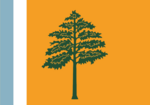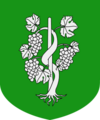Pacanesia
This article is incomplete because it is pending further input from participants, or it is a work-in-progress by one author. Please comment on this article's talk page to share your input, comments and questions. Note: To contribute to this article, you may need to seek help from the author(s) of this page. |
State of Pacanesia and Anesia Taheya o Pakaw e te Anaw'se (Pacanese) | |
|---|---|
Motto: Na Taheya o' Na Taheya 'My Country o' My Country!' | |
Anthem: "Prevail in the Seas" | |
| Capital and largest city | Jenni-Bahar |
| Capital-in-exile | Kahalie |
| Official languages |
|
| Regionalized language |
|
| Ethnic groups (2005) |
|
| Religion |
|
| Demonym(s) | Pacanese |
| Government | Federal hereditary dictatorship under foreign control |
• President | Tariqua Abadul |
| Legislature | General Kiuva |
| Legally administrated by Pohnpenesia and Riamo as a joint territory, local government in exile since 2010. | |
• Kingdom of Pacanay | 1785 |
• Riamese mandate | 1905 |
• Independence | 1930 |
• Pacanese civil war begins | 2005 |
• Invasion of Pacanesia and Riamo-Pohnpenesian control | 2010- |
| Area | |
• Total | 9,029 km2 (3,486 sq mi) |
• Water (%) | 1% |
| Population | |
• 2023 estimate | 980,000 |
• 2005 census | 1,548,000 |
| GDP (PPP) | 2023 estimate |
• Total | $23.3 billion |
| GDP (nominal) | 2023 estimate |
• Total | $23.3 billion |
| Gini | low |
| HDI (2023) | medium |
| Currency | Riamese hull (RMH) |
| Time zone | UTC+6 |
| Date format | dd/mm/yyyy |
| Driving side | right |
| Calling code | +451 |
| Internet TLD | .pc |
Pacanesia, officially the State of Pacanesia and Anesia (Pacanese: Taheya o Pakaw e te Anaw'se) is an an archipelagic nation located in the southern fringes of the Kaldaz Ocean. The nation is made up of 20 islands in 2 archipelagos, 12 in Pacanesia and 8 in Anesia. According to the World Assembly, as of 2023, Pacanesia has an estimated population of approximately 980,000. In contrast, the pre-war census conducted in 2005 reported a population of 1,548,000 inhabitants. The capital and largest city is Jenni-Bahar, home to over 500,000 people—over 50% of the entire country's population. The de facto capital-in-exile is Kahalie, which used to be the largest city at over 700,000 before the civil war in 2005.
Of the 2005 population, 51% identified as ethnically White, while 36% identified as ethnically Pacanese. 27.1% are grouped into the "Ultramaro and multiracial" category, which is primarily made up of Anáhuacese, Arab and Mixed people. The rest of the census group categorized as "other", 0.6% of the population.
Pacanesia's history spans two millenias, marked by the arrival of settlers via Pohnpenesia. Under various rulers, including kingdoms and tribedoms, it became a part of the Kaldaic Empire in the 13th century. Post-colonization in the late 16th century transformed the archipelago into the Kingdom of Pacanay in 1785. The 20th century witnessed Riamo's invasion, leading to Pacanesia becoming a Mandate of the Empire. Independence was achieved in 1930. In 2005, democratic mismanagement and dictatorship triggered a civil war. Riamo and Pohnpenesia invaded in 2010, establishing the Joint Territory of Pacanesia and exiling the government. The Civil War has plunged the nation into chronic poverty and conflict, displacing over half the population, causing over 350,000 casualties, mostly civilians, and decimating the economy.
Etymology
The etymology of the term "Pacanesia" is a subject of debate, with several theories claimed regarding its origin. The first and most widely accepted theory among scholars suggests a derivation from the Proto-Kaldaic root "p¹-kʷ," denoting wood, referring to the abundant forests in the region. Another theory, proposed by the Kaldaz Archaeology Institute, contends that "Pacanesia" may have originated from a Korsannean term, "pakua," meaning frost.
History
This article is incomplete because it is pending further input from participants, or it is a work-in-progress by one author. Please comment on this article's talk page to share your input, comments and questions. Note: To contribute to this article, you may need to seek help from the author(s) of this page. |
Geography
Pacanesia is an archipelagic territory of 20 islands, consisting of 2 main archipelagoes: Pacanesia and Anesia. 12 are grouped into the Pacanese Archipelago, and 8 are in the Anesia. The largest island is Pacanon, and the smallest island is Um Agaba.

